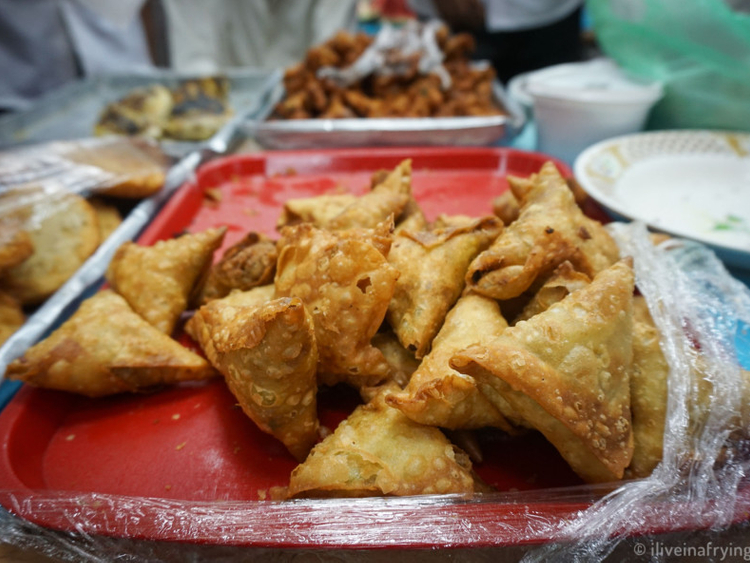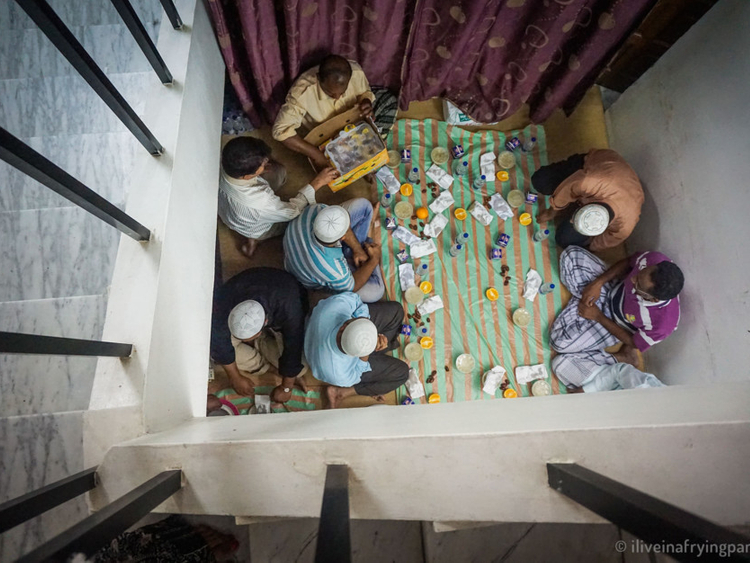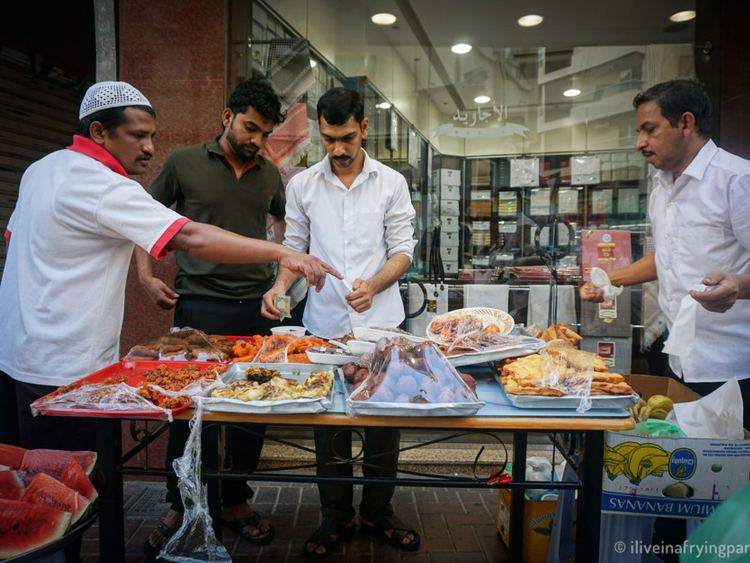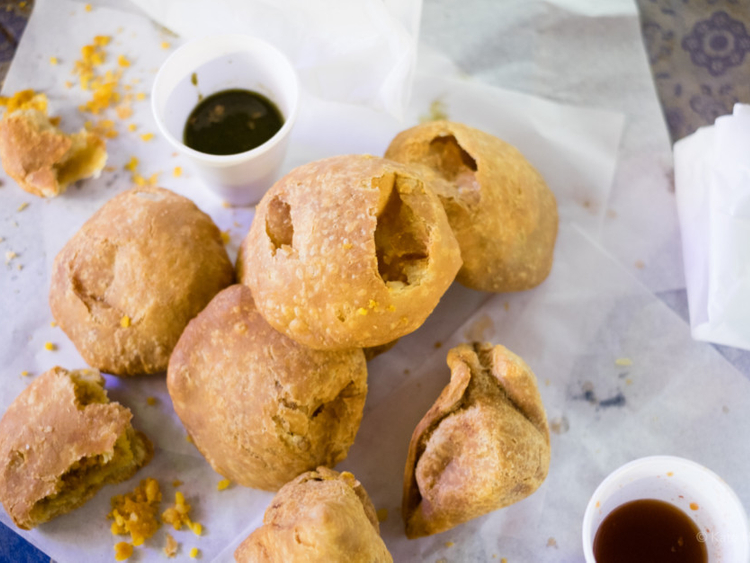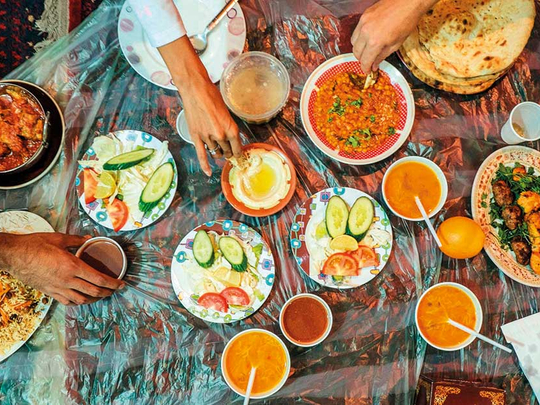
Blaring horns and rumbling noises as engines purr to life; people screaming to make their voices heard above the din; bus conductors shouting out routes and destinations; restaurant workers enticing passersby with their culinary fare; and high-decibel haggling — these are the everyday soundscapes that greet you on entering the vicinity of the Al Ghubaiba bus station in Bur Dubai.
The air here is resonant with a mixture of languages. And as the sunlight dips, flashy neon lights begin to twinkle on the tiny cafeterias and shops selling electronic wares and garish clothing.
This bustling thoroughfare is clearly not for those seeking peace and quiet; or yearning to experience anything remotely spiritual. Yet, it is here on a sultry, summer evening last week that we encounter the true spirit of Ramadan and witness firsthand the essence of compassion, generosity and togetherness that this holy month celebrates.
A group of us — 16 to be exact — stand outside the portals of Masjid Fatima Hassan Mohammed Yousef Bastaki, a bright pink mosque adjacent to the bus station, courtesy of the Unseen Trails — a collaboration between Gulf Photo Plus and Frying Pan Adventures. We have been lured by the promise of experiencing Ramadan from a local perspective while exploring unconventional areas of the city. We signed up for the Old Dubai Iftar Walk to improve photography skills and learn new techniques and to sample delicious snacks from the culinary gems in the area.
Our journey by foot begins at sharp 5.30pm outside the Dubai Museum in the Al Fahidi district. The majority of the group is keen on honing their street photography skills; others wish to explore the backstreets and delve into its rich history. Leading us on the trail is Kathleen Hoare, GPP Instructor, while Tanya Rehman serves as our culture and food guide.
Advising us to “push out of your comfort zones, and experiment with shutter speed, aperture, ISO, and white balance to discover new approaches and perspectives to taking images”, we follow Hoare as we walk past the Dubai Museum — built in 1787, it served as a fort of defence more than 200 years ago. Following renovations, the structure was officially opened as a museum in 1971, the year of the UAE’s formation. Hardly a few steps away is the Grand Mosque and our first stop on the tour.
As Rehman narrates the history of the mosque — originally built in 1900 as a kuttab or Quranic school, demolished and constructed in 1960, and razed and rebuilt again in 1998 to maintain the same style as its original — Hoare encourages us to pay attention to its architectural elements. Built in the traditional Islamic style, the Grand Mosque — with its sand-coloured walls, intricately carved windows and wooden shutters — boasts a 70 metres-high minaret, the tallest in Dubai. To get a better view of the numerous domes that adorn its rooftop, we follow Hoare up two rickety wooden ladders outside a shop nearby. As we capture the undulating rounded forms of the domes and the minaret under the clear, blue sky, we notice the shimmering waters of the Creek in the distance. The terrace itself is a sight to behold; its empty spaces taken up by old air-conditioners, computers, and all forms of junk including broken Turkish ceramic ware and glass baubles which, says Hoare, form great subject pieces for photography.
Down below, in the alleyways and courtyards of Souq Al Kabeer, history continues to evolve. The now refurbished area has been thriving since the 1800s. The rich Persian merchants of the past are long gone; their places taken by traders from mostly India and Pakistan. We notice that although the shops are still open, the general buzz around the area has quietened. “It is Ramadan, and people are getting ready for iftar,” explains Rehman, as we enter the textile souk.
Awash with colours and fabrics of all kinds, Souq Al Kabeer is a veritable kaleidoscope of textures and prints. From pastels and soft tones in lace, chiffon and georgette to geometric patterns, floral prints and pop art images, the souq also has plenty of tailoring shops and outlets selling trims and embellishments.
As we walk on, we learn that the month of Ramadan is the ninth month in the Islamic calendar, and the period when the Quran was first revealed to Prophet Mohammad (PBUH). Ramadan is therefore a celebration of the Quran’s revelation, says Rehman, “and the annual observance of a fast during this period also forms one of the five pillars of Islam.”
The word ‘Ramadan’, she explains, comes from the Arabic root ramad, which means scorching heat. “It is a time of spiritual reflection and awakening brought about through increased offering of prayers and recitation of the Quran.”
Walking through the streets, Hoare recommends using a slow shutter speed to get a ‘blur’ of people moving past. We approach Bin Magren Masjid, a box-like structure. The texture of the sand-toned walls contrasted with its dark windows to make it an ideal subject for black and white photography, she says.
She leads us on the opposite road to photograph its spiral minaret, from which the call to prayer is announced. Nearby is another mosque whose minaret features a viewing gallery.
Although the style and decoration of mosques can vary depending on the period and region of construction, almost all mosques share some common architectural features, explains Rehman. “One such element is the mihrab or niche in the wall that indicates the direction of Makkah, towards which all Muslims pray. The minaret is often the most visible aspect while the domes, called qubba, feature intricate motifs as it is a symbolic representation of the vault of heaven.”
Along the journey, we are constantly reminded of how Dubai once was; with its distinctive Arabian skyline and a bustling centre for trade and commerce.
We come to a halt, mesmerised by the breathtaking beauty of an Iranian matam (congregation hall) that rises majestically in one of the inner lanes. Inspired by Persian-style architecture, it is covered with extensive decorative blue tile mosaics. The gorgeous swirls of Arabic calligraphy blend well with bright floral patterns. Every piece of the faience tile is a work of art and Hoare urges us to capture them up close.
We cross an arch featuring a wall with exposed coral and limestone — the traditional building material of the yesteryears, and when we reach the family-run Masjid Fatima Hassan Mohammed Yousef Bastaki near the bus station, it is 6.30 pm and the muezzin’s call to prayer marking the end of fast for the day is still 33 minutes away.
Preparation for iftar, however, has commenced at this family-run mosque. Carpets have been laid out; plates filled with assorted fruits, fried snacks and the customary dates, a bottle of water, fruit juice and a small plate of lamb biryani are placed before each individual. The men sit in contemplative silence; some reciting holy verses; others offering silent prayers. They could be strangers or friends, traders or labourers, rich or poor — all the ‘differences’ seem now immaterial when bound together by devotion and faith.
A serene calmness envelops the entire area; peace has descended on this otherwise cacophonic thoroughfare. Seats fill up in no time while others wait patiently in line and find space on the kerb-side. Meanwhile, Hoare cautions us to be respectful while taking portraits. “See them as individuals as opposed to mere subjects in your photographs,” she says.
As it nears 7:03 pm, we make our way to a passage between two shops where Rehman has spread out dates and water, and generous servings of biryani — a kind and sharing gesture of the Bastaki mosque team. When the muezzin’s call goes out, a murmur of a prayer is heard, and with that, we join hundreds of worshippers in ending the day’s fast with dates and water.
It is a blessed moment; this simple act of sharing a humble meal together heightens the spirit of unity and fraternity; and helps reconnect with your spirituality in ways that you never thought possible. Much as we would like to savour this soul-stirring moment even longer, it is time for us to move on as the devout hurry to the mosque to offer prayers.
The area now wears a deserted look and we focus on post-iftar images — clear streets, vacant seats and heaps of empty plates.
Rehman decides we need to replenish our stomachs and so it is a pillowy pav (bread) stuffed with a lightly spiced potato mixture, fried in gram flour and drizzled with sweet tamarind and coriander chutneys that we devour at an Indian tea shop. Vada pav, the quintessential street food of the city of Mumbai, is starch heaven, she adds, but we are not listening as the taste wins us over, and we down it with steaming hot karak tea.
We end our day with soft, delicious fresh-off-the-oven tandoor egg rotis and cream cheese stuffed roti at a decades-old Afghan bakery across the street. Before we leave our separate ways, Rehman herds us into a Mumbai snack and pickle store where the aroma of 25 assorted fresh pickles and a variety of savoury snacks give us a hint of maximum flavour.
It is 8.30 pm and around us, the chaos is back in action, as teeming crowds and vehicles jostle for space on the clogged roads. However, those brief moments of tranquility and inner calm when we nourished our souls in the time leading up to iftar will forever remain etched as the treasured memory of a glorious Ramadan in Dubai.
Sangeetha Swaroop is a writer based in Dubai.
The Ramadan/Old Dubai Iftar Walk runs on June 4, 5, 6, and 11. For more info, visit gulfphotoplus.com/workshops/81/Ramadan-Old-Dubai-Iftar-Walk




